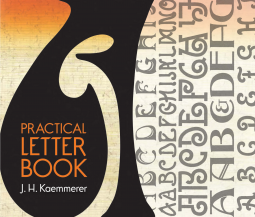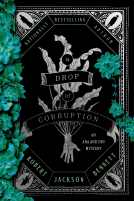
Practical Letter Book
by J. H. Kaemmerer
This title was previously available on NetGalley and is now archived.
Send NetGalley books directly to your Kindle or Kindle app
1
To read on a Kindle or Kindle app, please add kindle@netgalley.com as an approved email address to receive files in your Amazon account. Click here for step-by-step instructions.
2
Also find your Kindle email address within your Amazon account, and enter it here.
Pub Date Aug 17 2016 | Archive Date Nov 16 2016
Description
The 140 plates feature numerous historic and modern styles from throughout Europe, including examples based on Latin, Greek, Hebrew, and Gothic originals. Selections include English and Dutch block letters; Roman, German, and French letters; script and Gothic letters; a variety of contemporary letters; foreign alphabets; numerals; and a sampling of monograms and vignettes. The compilation's original intent as a resource for sign painters ensures the eye-catching quality of its contents, making this volume an enduring source of possibilities and inspiration.
Available Editions
| EDITION | Paperback |
| ISBN | 9780486806761 |
| PRICE | $19.95 (USD) |
Featured Reviews
 Rob v, Reviewer
Rob v, Reviewer
The ‘Practical Letter Book‘ is a reprint of a in 1911 originally published book, which shows an overview of fonts and typography meant to inspire artists, painters and others. It is a delightful historical source of hand-painted typography. You can recognize fonts which are used in many Art Nouveau posters from the late 1900s.
It discusses how to draw these types; shading, spacing, why some letters need raising and why others do not. Typography has changed a lot since the coming of the computer and has almost turned into a lost art, this book should be a must-read for every younger designer who just knows how to set type with a computer. Not to learn how to draw type (would not be bad though) but more to learn the ideas behind type; why some letters need more spacing, why some letters are raised and so on. It provides a treasure on background info.
The ‘Practical Letter Book‘ is a gem towards the history of typography, a must-have for designers!
 Kristin C, Reviewer
Kristin C, Reviewer
This book was first published in 1911 and is being re-released but it is still a good reference for graphic artist or anyone interesting in lettering and calligraphy.
As someone who appreciates lettering, font and calligraphy, I found this to be an extremely interesting read! I love learning about the history of lettering, and this title had that and more!
I would highly recommend this title to anyone that has a graphic design or calligraphy background. As the holidays are approaching, I have a few friends in mind that would greatly enjoy this book,
Thank you to NetGalley for the ARC in exchange for an honest review.
 roxi N, Reviewer
roxi N, Reviewer
Like many Dover books, this is a simple but beautiful book with plates of fonts/texts that can easily be considered artwork and framed. I'm tempted to do so!
 Leyla J, Reviewer
Leyla J, Reviewer
The Introduction says that this book is mainly aimed at student and sign writers. I found the information very good especially in order to familiarise myself with the characteristics of the different fronts.
There is a description and information of each of the fronts at the beginning of the book, with reference to plate further in the book. I use fonts for my artwork so it is nice to actually get some information about the features of each one. A book that will be well used.
 Stephanie D, Reviewer
Stephanie D, Reviewer
This is a guide book for painters, signwriters or people interested in graphic design, focusing on how to use text in an eyecatching but readable format. The book has some text explaining the history and uses of certain types of text, but is mostly made up of examples. There are 140 plates showing the different types of lettering.
The lettering examples are beautiful, and i will probably be copying them for art projects (and addressing birthday cards), but to be honest it's a bit dry. I was epecting something a little bit more interesting.
 Caitie C, Bookseller
Caitie C, Bookseller
Nicely done...lovely...a great book for the journaling art section. Xox...@ cowgirl caities blogspot Also facebook, twitter, pinterest and goodreads xo
 Ashley C, Educator
Ashley C, Educator
neat book with creative lettering and ideas for my own hand lettering. Thank you for the copy!
 Reviewer 332909
Reviewer 332909
This book was a very informative read. Each font type is explained at the start of the book and has examples of each font type. The book was published in 1911 and it is a fascinating look into how graphic design was carried out. The language of the book is fairly easy to read. The text is short and to the point. The real value is in the examples of the fonts.
 Ionia F, Reviewer
Ionia F, Reviewer
If you are an artist, sign maker or in any other business or hobby where lettering comes into play, you really want to get this book. Practical it may be, but it is also a lot of fun. This book explains the fonts in the beginning and then goes on to show you some absolutely stunning examples of them in use later on.
These would be great for anyone who does craft projects, or students who are learning to expand their horizons. I think basically anyone could get use out of this book in some way. The introduction was really interesting too, and the author obviously knows what they are talking about, so it made me feel confident.
This is a really helpful book.
This review is based on a complementary copy from the publisher, provided through Netgalley. All opinions are my own.
This was initially published in 1911 as <em>Kaemmerer's Practical Letter Book: Containing Several Hundred Alphabets in 140 Plates; Together with Descriptive Text, For the Use of Sign Painters, Show Card Writers, Decorators, Artists and Craftsmen</em>. While I am none of those professions, I am fascinated by calligraphy and word art. Kaemmerer's title has stood the test of time and the plates were a delight to look through. This is not a modern how-to guide! The first portion contains specific considerations of the letters and words in different situations while the second contains the beautiful plates. For example, in the case of the English Block Letter: <em>"The M. W. and Y. should be one-third wider than the other letters... These proportions however are by no means arbitrary but must be varied according to the particular word that is being painted. A case where a variation is very necessary is where a sign is to be placed at an elevation and is to be viewed from the ground, for instance, if it is even 10 ft. high it might be necessary to slightly thicken the top and bottom portions of the letter so as to allow for the shortening which comes about from viewing the letters at an angle."</em> There is a considerable amount of useful information for calligraphers, sign painters, and anyone fascinated by lettering. Some modern readers will be disappointed in this book with its lack of tutorials. However I am thankful this title is republished and available today to a new audience.












